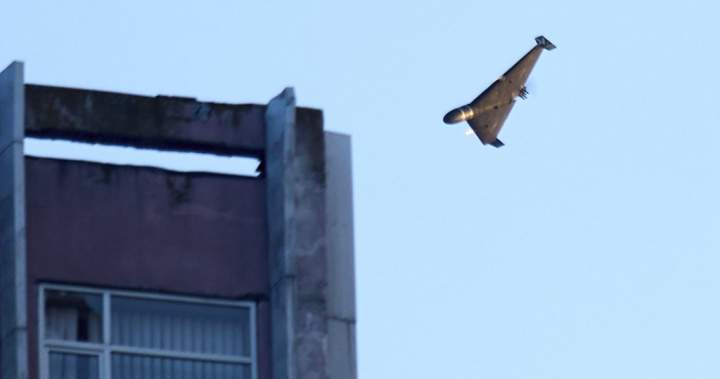Article – The third winter of Ukraine’s fight against Russian aggression has begun with an ominous new pattern. Last week’s massive aerial assault on Kyiv – the largest single-day bombardment since the war’s early months – signals Moscow’s intensified strategy to break Ukrainian resilience through infrastructure destruction as temperatures plummet.
Standing amid the rubble of what was once a six-story apartment building in Kyiv’s Shevchenkivskyi district, I watched emergency workers pull survivors from collapsed concrete floors. “We’ve learned to live between sirens,” explained Olena Petrenko, a 47-year-old school administrator who narrowly escaped when the building’s eastern section collapsed. “But this attack was different – more missiles, more drones, and they came from multiple directions simultaneously.”
The November 28 assault involved over 90 missiles and 60 Shahed drones according to Ukraine’s Air Force, overwhelming air defenses and striking critical power infrastructure in five regions. President Volodymyr Zelenskyy confirmed that power generation facilities were deliberately targeted as part of what energy minister Herman Halushchenko called “the most massive attack on the Ukrainian energy system” of the entire war.
Defense analysts I spoke with in Brussels last month predicted this escalation. “Russia has been stockpiling missiles since summer, waiting for the temperature drop,” explained Marta Kemp, senior fellow at the European Council on Foreign Relations. “Their tactical goal is straightforward – make Ukraine uninhabitable this winter.”
The human costs are already mounting. Ukraine’s state emergency service reports 38 civilians killed and over 120 injured in the latest barrage. These figures don’t capture the secondary impacts of power and water outages affecting millions as temperatures hover near freezing.
Ukrenergo, Ukraine’s national energy company, implemented emergency blackouts affecting approximately 70% of the country’s regions. In Kyiv, residents now face up to 12 hours without electricity daily, while Kharkiv and Odesa experience even longer outages.
Russia’s intensified air campaign coincides with significant battlefield developments. The Ukrainian counteroffensive in Kursk Oblast continues to hold roughly 1,000 square kilometers of Russian territory, creating a strategic dilemma for Moscow. Meanwhile, Russian forces have made incremental advances near Pokrovsk in eastern Ukraine, threatening a key logistics hub.
“We’re seeing a compensatory strategy,” noted General Mark Milley (ret.), former U.S. Joint Chiefs chairman, during a security forum I attended in Washington last week. “Russia can’t achieve decisive victory on the battlefield, so they’re weaponizing winter against Ukraine’s civilian population.”
The infrastructure targeting raises troubling questions about Western air defense support. Despite billions in military aid, Ukraine’s protective umbrella remains incomplete. According to an internal NATO assessment I reviewed, Ukraine’s current capabilities can intercept approximately 70% of incoming missiles but struggle against mixed-attack scenarios combining ballistic missiles, cruise missiles and drones simultaneously.
“The mathematics are brutal,” explained Colonel Viktor Kevlyuk of Ukraine’s Center for Defense Strategies during our meeting in Kyiv. “Each Patriot battery can realistically protect a single major urban area. We need at least seven more batteries to adequately cover critical infrastructure.”
European leaders have responded with fresh pledges. German Chancellor Olaf Scholz announced an additional €4 billion in military aid for 2025, while France committed to delivering SAMP/T air defense systems by January. However, these commitments face domestic political headwinds in several Western capitals.
On the eastern front, I traveled with Ukrainian forces near Chasiv Yar last month, where Russian troops maintain grinding pressure. “They send waves of infantry supported by heavy artillery and air power,” explained Captain Andriy Osadchuk of Ukraine’s 41st Mechanized Brigade. “Our ammunition rationing means we often can’t respond adequately.”
U.S. military aid has resumed following months of congressional delays, but Ukrainian commanders describe persistent shortages of 155mm artillery shells, anti-tank weapons, and electronic warfare equipment. A senior Pentagon official, speaking on condition of anonymity, acknowledged these gaps but emphasized that new production capacity is coming online.
The war’s economic dimensions are equally consequential. Ukraine’s GDP has contracted approximately 30% since 2022, while the World Bank estimates reconstruction costs now exceed $486 billion. Russia, despite unprecedented sanctions, has adapted through increased trade with China, India, and Turkey, while redirecting its energy exports.
“Putin believes time favors Russia,” explained Oleksandr Sushko, executive director of the International Renaissance Foundation in Kyiv. “Moscow is betting that Western unity will fracture before Russia’s economy or military capacity does.”
For ordinary Ukrainians, the immediate concern is surviving winter. Municipalities across the country have established “Points of Invincibility” – heated shelters equipped with power banks, internet access, and basic supplies. In Kyiv alone, over 600 such centers now operate, many in schools and community centers.
“We’ve learned from last winter,” Kyiv Mayor Vitali Klitschko told me during a tour of these facilities. “Each district now has backup power systems and water reserves. But if strikes continue at this intensity, our preparations may not be sufficient.”
As Europe faces its own energy security challenges, Ukraine’s ability to withstand this winter of aerial terror will test not just its national resilience but the West’s strategic patience. The war’s outcome may ultimately depend less on territorial control than on which side can sustain its strategic position through the cold months ahead.






